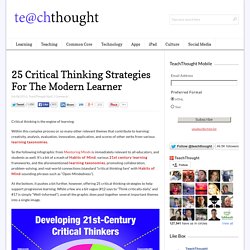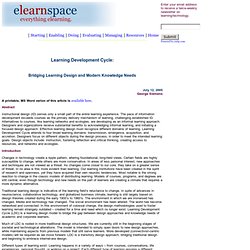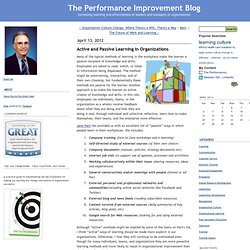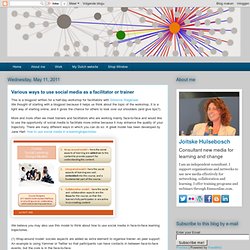

Beating the Forgetting Curve with Distributed Practice. “If you read the research on how much people forget after training, it’s depressing.

Do a search for the ‘Forgetting Curve’. Once we know something like this, we need to change our approach and educate others.”- Connie Malamed (The eLearning Coach)The above quote is from our interview with Connie Malamed.
70:20:10. 25 Critical Thinking Strategies For The Modern Learner. Critical thinking is the engine of learning.

Within this complex process or so many other relevant themes that contribute to learning: creativity, analysis, evaluation, innovation, application, and scores of other verbs from various learning taxonomies. So the following infographic from Mentoring Minds is immediately relevant to all educators, and students as well. It’s a bit of a mash of Habits of Mind, various 21st century learning frameworks, and the aforementioned learning taxonomies, promoting collaboration, problem-solving, and real-world connections (standard “critical thinking fare” with Habits of Mind-sounding phrases such as “Open-Mindedness”). At the bottom, it pushes a bit further, however, offering 25 critical thinking strategies to help support progressive learning.
While a few are a bit vague (#12 says to “Think critically daily,” and #17 is simply “Well-informed”), overall the graphic does pool together several important themes into a single image.
Mentoring. Giving presentations. PKM Course. Cognitive load. Scenario based learning. Personal learning management. Coaching. Learning Styles. Informal learning. Storytelling for learning. 49985_EN.pdf (application/pdf Object) Groups and learning. Reflective practice. Authentic learning. ADDIE. Learning Development Cycle. Learning Development Cycle: Bridging Learning Design and Modern Knowledge Needs July 12, 2005 George Siemens A printable, MS Word verion of this article is available here.

Abstract Instructional design (ID) serves only a small part of the entire learning experience. Introduction Changes in technology create a ripple pattern, altering foundational, long-held views.
GetTRDoc (application/pdf Object) Mastering Education. Program evaluation. Workplace assessment. Communities of Practice. Connected Learning Infographic. Design Thinking for Educators. Press Release - Communications Office. Apr 19, 2012 Scientists have discovered proof that the evolution of intelligence and larger brain sizes can be driven by cooperation and teamwork, shedding new light on the origins of what it means to be human.

The study appears online in the journal Proceedings of the Royal Society B and was led by scientists at Trinity College Dublin: PhD student, Luke McNally and Assistant Professor Dr Andrew Jackson at the School of Natural Sciences in collaboration with Dr Sam Brown of the University of Edinburgh. The researchers constructed computer models of artificial organisms, endowed with artificial brains, which played each other in classic games, such as the ‘Prisoner's Dilemma’, that encapsulate human social interaction.
They used 50 simple brains, each with up to 10 internal processing and 10 associated memory nodes. The brains were pitted against each other in these classic games. Let’s Put Informal Learning to Work. Posted on April 21st, 2012 Six years ago, Pfeiffer published Informal Learning, Rediscovering the Natural Pathways that Inspire Innovation and Performance.

The book advanced the then-controversial thesis that people mostly learn their jobs experientially. Workers learn more in the coffee room than in the classroom. They do not moveI thought I had made a sound business case for investing more in informal learning, but few organizations changed their ways. They continued to put almost all of the training budget into schooling novices. Nicenet. Only 14% think that company training is an essential way for them to learn in the workplace. UPDATE: Survey has re-opened.

Submit your own data and find out the current pattern of results of how people prefer to learn at work. That was one of the findings of my recent anonymous survey on how people learn best in the workplace, and even I was surprised by the results. But I think the biggest take-away from my survey is that we can no longer assume we know how people like to learn in the workplace nor how we think people should learn. So in this blog post, I want to share the data from my survey, some of my thoughts about the results, and the importance of undertaking your own survey.
The survey’s main question asked respondents to rate the importance of 10 different ways of learning in the workplace - as “Not important”, “Somewhat important”, “Very Important” or “Essential”. Active and Passive Learning in Organizations. Many of the typical methods of learning in the workplace make the learner a passive recipient of knowledge and skills.

Employees are asked to read, watch, or listen to information being dispensed. Life in perpetual Beta. Lasagna and chips: Various ways to use social media as a facilitator or trainer. This is a blogpost written for a half-day workshop for facilitators with Sibrenne Wagenaar.We thought of starting with a blogpost because it helps us think about the topic of the workshop, it is a light way of starting online, and it gives the chance for others to look over our shoulders (and give tips?).

More and more often we meet trainers and facilitators who are working mainly face-to-face and would like to use the opportunity of social media to facilitate more online because it may enhance the quality of your trajectory. There are many different ways in which you can do so. A great model has been developed by Jane Hart: how to use social media in e-learningtrajectories: We believe you may also use this model to think about how to use social media in face-to-face learning trajectories. (1) Wrap-around model: socials aspects are added as extra element to organise trainer- en peer support.
The Social Learning Revolution. [The substance of this article is also available as an Internet Time Alliance whitepaper in PDF format] “A revolution is a fundamental change in power or organizational structures that takes place in a relatively short period of time.”

(Wikipedia) Self-efficacy information.